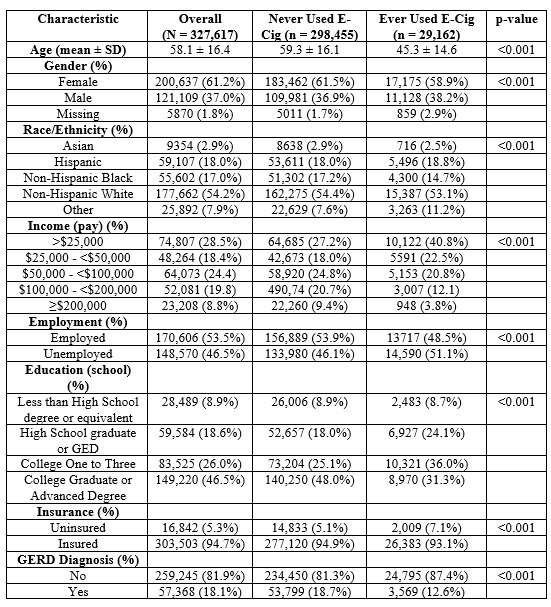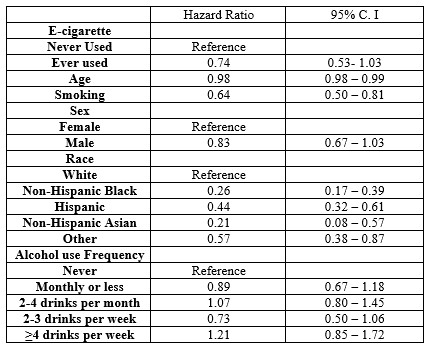Tuesday Poster Session
Category: Esophagus
P4924 - Association Between Electronic Cigarette Use and Risk of Eosinophilic Esophagitis: A Retrospective Cohort Study
Tuesday, October 28, 2025
10:30 AM - 4:00 PM PDT
Location: Exhibit Hall
.jpg)
Boniface Mensah, MBChB, MPh
MedStar Georgetown University Hospital
Baltimore, MD
Presenting Author(s)
Boniface Mensah, MBChB, MPh1, Albert E.. Orhin, MBChB, MHS2, Natalie A.Y.. Akoto, MBChB, MPH1, Seunghee Han, MBChB1, Kevin Eid, MD1, Simardeep Singh, MBBS1, Joseph Atarere, MD1, Haider A. Naqvi, MD3
1MedStar Georgetown University Hospital, Baltimore, MD; 2Ascension Saint Agnes Hospital, Baltimore, MD; 3MedStar Franklin Square Medical Center, Baltimore, MD
Introduction: Eosinophilic esophagitis (EoE) is a chronic, immune-mediated esophageal disease with rising incidence, particularly among younger populations. While conventional smoking has been associated with altered mucosal immunity, little is known about the impact of electronic cigarette (e-cigarette) use on EoE risk. We aimed to evaluate the association between e-cigarette use and incidence of EoE in a large, diverse U.S. population.
Methods: We conducted a retrospective cohort study using the NIH All of Us Research Program, which integrates electronic health records (EHR) with detailed participant survey data. E-cigarette use (ever vs. never) was self-reported using standardized survey instruments. Participants with a diagnosis of EoE at baseline were excluded. The primary outcome was time to incident EoE diagnosis, identified through EHR data. Cox proportional hazards models were used to estimate the association between e-cigarette use and EoE, adjusting for age, gender, race/ethnicity, smoking history, alcohol use, GERD, education, employment, income, and insurance status.
Results: A total of 432,023 participants were included, with 431 incident EoE cases identified. The median time to EoE diagnosis was 49.6 months (IQR: 21.8–59.5). Compared to non-users, e-cigarette users were younger (mean age 45.3 vs. 59.3 years), more likely to be male, and had higher rates of traditional smoking. In the adjusted analysis, ever e-cigarette use was associated with a non-significant trend toward reduced EoE risk (adjusted HR: 0.74, 95% CI: 0.53–1.03). Traditional smoking was independently associated with lower EoE risk (HR: 0.64, 95% CI: 0.50–0.81). Asian (HR: 0.21, 95% CI: 0.08–0.57), Hispanic (HR: 0.44, 95% CI: 0.32–0.61), and Black study participants (HR: 0.26, 95% CI: 0.17–0.39) had significantly lower risks of EoE compared to non-Hispanic Whites.
Discussion: In this large, nationally representative cohort with self-reported e-cigarette use data, there was no significant association between e-cigarette use and EoE incidence. However, a trend toward a protective effect was observed. The findings could suggest a potential immunomodulatory role of nicotine. Larger longitudinal studies are needed to validate these findings and explore underlying mechanisms.

Figure: Table 1: Demographic Characteristics of Study Participants

Figure: Table 2: Multivariable Cox Proportional Hazards Model for Eosinophilic Esophagitis
Disclosures:
Boniface Mensah indicated no relevant financial relationships.
Albert Orhin indicated no relevant financial relationships.
Natalie Akoto indicated no relevant financial relationships.
Seunghee Han indicated no relevant financial relationships.
Kevin Eid indicated no relevant financial relationships.
Simardeep Singh indicated no relevant financial relationships.
Joseph Atarere indicated no relevant financial relationships.
Haider Naqvi indicated no relevant financial relationships.
Boniface Mensah, MBChB, MPh1, Albert E.. Orhin, MBChB, MHS2, Natalie A.Y.. Akoto, MBChB, MPH1, Seunghee Han, MBChB1, Kevin Eid, MD1, Simardeep Singh, MBBS1, Joseph Atarere, MD1, Haider A. Naqvi, MD3. P4924 - Association Between Electronic Cigarette Use and Risk of Eosinophilic Esophagitis: A Retrospective Cohort Study, ACG 2025 Annual Scientific Meeting Abstracts. Phoenix, AZ: American College of Gastroenterology.
1MedStar Georgetown University Hospital, Baltimore, MD; 2Ascension Saint Agnes Hospital, Baltimore, MD; 3MedStar Franklin Square Medical Center, Baltimore, MD
Introduction: Eosinophilic esophagitis (EoE) is a chronic, immune-mediated esophageal disease with rising incidence, particularly among younger populations. While conventional smoking has been associated with altered mucosal immunity, little is known about the impact of electronic cigarette (e-cigarette) use on EoE risk. We aimed to evaluate the association between e-cigarette use and incidence of EoE in a large, diverse U.S. population.
Methods: We conducted a retrospective cohort study using the NIH All of Us Research Program, which integrates electronic health records (EHR) with detailed participant survey data. E-cigarette use (ever vs. never) was self-reported using standardized survey instruments. Participants with a diagnosis of EoE at baseline were excluded. The primary outcome was time to incident EoE diagnosis, identified through EHR data. Cox proportional hazards models were used to estimate the association between e-cigarette use and EoE, adjusting for age, gender, race/ethnicity, smoking history, alcohol use, GERD, education, employment, income, and insurance status.
Results: A total of 432,023 participants were included, with 431 incident EoE cases identified. The median time to EoE diagnosis was 49.6 months (IQR: 21.8–59.5). Compared to non-users, e-cigarette users were younger (mean age 45.3 vs. 59.3 years), more likely to be male, and had higher rates of traditional smoking. In the adjusted analysis, ever e-cigarette use was associated with a non-significant trend toward reduced EoE risk (adjusted HR: 0.74, 95% CI: 0.53–1.03). Traditional smoking was independently associated with lower EoE risk (HR: 0.64, 95% CI: 0.50–0.81). Asian (HR: 0.21, 95% CI: 0.08–0.57), Hispanic (HR: 0.44, 95% CI: 0.32–0.61), and Black study participants (HR: 0.26, 95% CI: 0.17–0.39) had significantly lower risks of EoE compared to non-Hispanic Whites.
Discussion: In this large, nationally representative cohort with self-reported e-cigarette use data, there was no significant association between e-cigarette use and EoE incidence. However, a trend toward a protective effect was observed. The findings could suggest a potential immunomodulatory role of nicotine. Larger longitudinal studies are needed to validate these findings and explore underlying mechanisms.

Figure: Table 1: Demographic Characteristics of Study Participants

Figure: Table 2: Multivariable Cox Proportional Hazards Model for Eosinophilic Esophagitis
Disclosures:
Boniface Mensah indicated no relevant financial relationships.
Albert Orhin indicated no relevant financial relationships.
Natalie Akoto indicated no relevant financial relationships.
Seunghee Han indicated no relevant financial relationships.
Kevin Eid indicated no relevant financial relationships.
Simardeep Singh indicated no relevant financial relationships.
Joseph Atarere indicated no relevant financial relationships.
Haider Naqvi indicated no relevant financial relationships.
Boniface Mensah, MBChB, MPh1, Albert E.. Orhin, MBChB, MHS2, Natalie A.Y.. Akoto, MBChB, MPH1, Seunghee Han, MBChB1, Kevin Eid, MD1, Simardeep Singh, MBBS1, Joseph Atarere, MD1, Haider A. Naqvi, MD3. P4924 - Association Between Electronic Cigarette Use and Risk of Eosinophilic Esophagitis: A Retrospective Cohort Study, ACG 2025 Annual Scientific Meeting Abstracts. Phoenix, AZ: American College of Gastroenterology.
